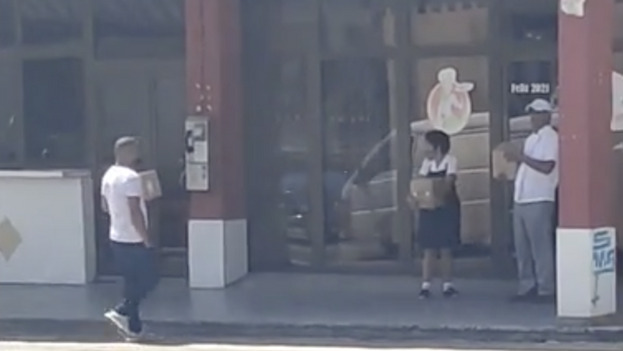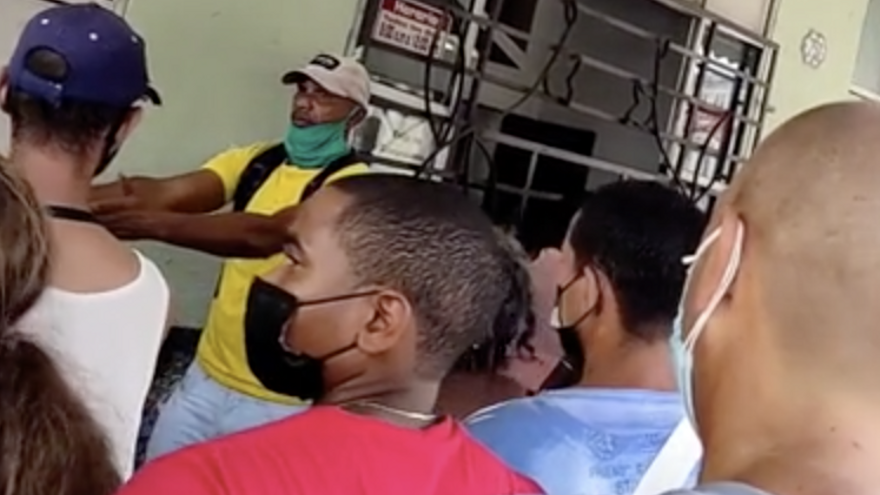
![]() 14ymedio, Natalia López Moya, Havana, 21 September 2021 — A crowd gathered this Monday at the Infanta and Carlos III premises known as El Cuchillo at the same time that ice cream began to be unloaded from a recently parked vehicle. Dairy pleasure is increasingly scarce in Cuba and, therefore, all the passers-by who happened to be around came, eager and ready to line up.
14ymedio, Natalia López Moya, Havana, 21 September 2021 — A crowd gathered this Monday at the Infanta and Carlos III premises known as El Cuchillo at the same time that ice cream began to be unloaded from a recently parked vehicle. Dairy pleasure is increasingly scarce in Cuba and, therefore, all the passers-by who happened to be around came, eager and ready to line up.
Many of those who desperately asked “who’s last in line” — so they could take their proper place behind them — did not even know what flavor they were going to get, much less its price. When they had been waiting for a while and found out how much it was going to cost, some of them had to leave the line because they did not have enough cash on them.
The 10-liter box of vanilla ice cream cost 520 pesos and only one was being sold per person. There were also small guava popsicles, at 15 pesos each, with a limit of 10 per buyer.
“The police have to come and mistreat us in order for us to get organized,” said one of those who waited under the sun at one in the afternoon. “Look how they have us, just to try to buy some ice cream, this is the last straw”
“The police have to come and mistreat us in order for us to get organized,” said one of those who waited under the sun at one in the afternoon. “Look how they have us, just to try to buy some ice cream, this is the last straw.”
The fascination for ice cream does not come only from the heat and the need to put something very cold in your mouth. In the 1970’s and 1980’s, Fidel Castro became obsessed with large livestock schemes that would make Cuba a dairy power.
Numerous cheese, yogurt and ice cream factories were established and, with technology from the socialist camp, State ice cream parlors opened throughout the whole country.

But little remains of those menu boards that announced dozens of flavors, and the product is scarce in Cuban pesos. Now, ice cream is barely sold in some parts of the Cuban capital, and when it appears, it provokes more conflicts and fights than relief.
Just as a plainclothes agent was giving orders to position people, before the sale to the public began, those already lined up watched with surprise as workers from the El Italiano Pizzeria, located opposite El Cuchillo, came out with tubs of ice cream without having to wait for a place in line. The line then became a roar, but the protests were of little use: they only sold to the first 12 lucky ones, and the rest had to settle for 10 popsicles per person. Most left with empty bags and the bitter experience of having lost almost an hour of their lives.
“This is disrespectful, are they going to tell us that they only unloaded 12 boxes, nothing else?” One woman wondered indignantly. “How far will these people’s impudence against the citizens go? What do I tell my children now? That they have no right to eat ice cream? No ice cream, no candy, nothing,” she exploded.
“This is disrespectful, are they going to tell us that they only unloaded 12 boxes, nothing else?” One woman wondered indignantly. “How far will these people’s impudence against the citizens go?”
At the casual market and at home delivery outlets, the same tub of ice cream costs twice as much. This Tuesday, several establishments that make home deliveries offered vanilla flavored tubs at 1,100 pesos each. The resale market is a profitable business in the case of this product, highly sought after by families with children and convalescent patients who cannot eat solid foods.
On the outskirts of La Dependiente Hospital, in the Havana municipality of Diez de Octubre, three out of five people who waited this Monday to deliver lunch containers to their hospitalized relatives, such as Covid patients, also brought ice cream. “My cousin just wants to eat this, so if I have to look for it buried underground, I’ll do it,” commented a woman.
The fights to get the most precious dairy product every day are not new. Recently, this newspaper found the same problem at Ditá, at 26th and 37th Avenues in the Nuevo Vedado neighborhood in Havana. More than 40 people lined up in the sun to try to buy six-packs of ice cream, which were selling for 258 pesos.
Meanwhile, the famous ice cream parlor of the capital, Coppelia, has limited the purchase of ice cream to a few scoops per person and its offers are purely to take away, as long as each customer brings their own container, since they do not sell containers there. Despite this, this Tuesday the line in Coppelia was stubborn like the drizzle under which Havana dawned.
“We Cubans are going to kill each other,” protested a woman in a custodian uniform as she left El Cuchillo this Monday, when the ice cream had already run out. A young man replied: “Those who are going to kill us are those up there, those who do not line up and have us all day running from here to there.”
Translated by Norma Whiting
____________
COLLABORATE WITH OUR WORK: The 14ymedio team is committed to practicing serious journalism that reflects Cuba’s reality in all its depth. Thank you for joining us on this long journey. We invite you to continue supporting us by becoming a member of 14ymedio now. Together we can continue transforming journalism in Cuba.
